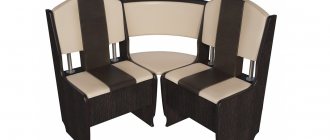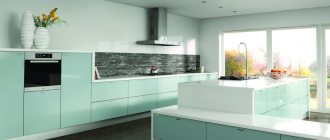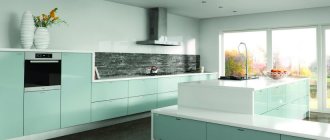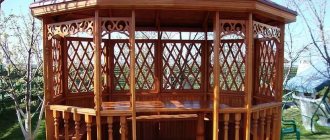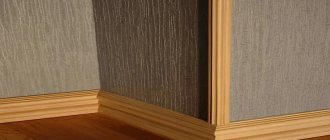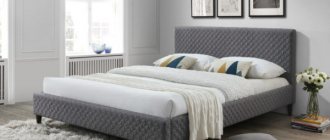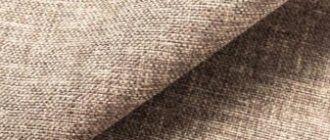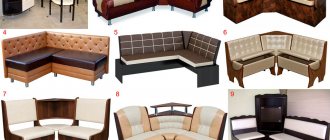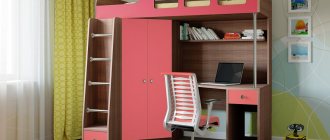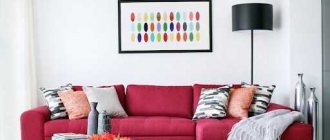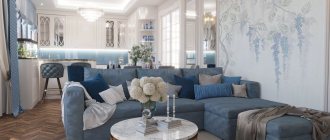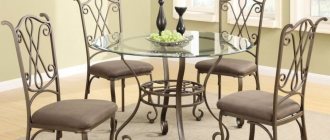One of the popular design solutions used when decorating a kitchen is installing a corner. This piece of furniture has earned popularity due to its functionality, attractive appearance and the ability to optimize the use of space.
This is especially important for small rooms. However, even in spacious kitchens, a corner will not be out of place - it will perfectly perform zoning of space.
DIY kitchen corner - drawings and diagrams
Varieties of design
A kitchen corner is a set of furniture, the main elements of which are a compact corner sofa and a dining table.
It is complemented by several chairs, stools or poufs. Kitchen corners vary in size, but in most cases they are created taking into account the principles of ergonomics and space saving. Based on the type of construction, this type of furniture is divided into left-handed, right-handed and universal. The first two options are characterized by the fact that the sofas included in their package consist of one long and one extension section. The left-side sofa has the shape of the letter L, the right-side is turned in the opposite direction, and looks like the number 7. Universal models consist of two sections of equal length.
Left-handed Right-handed Universal
The table of the furniture set can be:
- square;
- rectangular;
- oval;
- round.
On sale you can find models without a dining area. However, corners with a table do not need to be additionally equipped, so they are very popular. The design may include storage space in the sofa tray, and the upholstered furniture itself can be folding, transformable into a sleeping place. The tables are also different. They can be equipped with shelves or drawers for storing cutlery. Sometimes the set includes wall shelves or cabinets for dishes and kitchen utensils.
Square table
Rectangular
Oval Round Without table
What else to pay attention to when choosing the size of the kitchen corner
What criteria are best to adhere to when choosing?
First of all, the following information should be known:
- Kitchen area.
If the footage is small, only compact sets are considered (the dimensions of the kitchen corners with photos can be viewed in advance on the store’s website). - Number of family members.
It is necessary to choose the right table. A table for 6 people is considered a universal option. - Finishing method.
When researching this parameter, personal preferences, fashion trends and the style of the room as a whole are taken into account.
Kitchen corners of large and small sizes can be divided into two subgroups:
- Stationary corners
. These are one-piece structures, where two parts are connected to each other by fastening under the seat and on the back side, and one of the parts is longer than the other (the so-called L-shaped model). There was a time when all models were produced in one piece, non-separable, which caused a lot of inconvenience in operation. After all, the layout of the room may require the use of different types of corner sofas - both right-handed and left-handed. Therefore, over time, manufacturers began to produce similar furniture in different designs, which brought additional convenience to the consumer. - Modular models.
They are becoming more and more popular. This is facilitated by the mobility of structures consisting of several parts that can be removed altogether or swapped. This option is very convenient when there is a need to convert furniture from left-handed to right-handed, or vice versa.
If necessary, each module can be used separately, because all the elements are not fastened together, but only shifted. This option also has disadvantages. Considering that the pieces of furniture stand close to each other and are not fixed to either the floor or the walls, displacement occurs over time, and gaps form between the joints. Therefore, the elements will have to be shifted periodically, returning them to their original position.
The cost of stationary models is lower than that of modular ones. Therefore, if the location and shape of the corner are already indicated, it is better to purchase them. It is better to spend the difference on purchasing more expensive and high-quality upholstery material.
- L-shaped corner.
The best option in conditions of limited space. It is installed close to the wall to free up as much space as possible for the table. In such models, the back is usually small in thickness, but quite high and comfortable. One of the seats is often longer than the other, but the manufacturer can shorten it if necessary. - U-shaped model.
It looks very impressive, but only in a spacious room. Considering the footage of most typical apartments, the size of the soft kitchen corner will allow the installation of such a structure only in case of redevelopment. Of course, if the apartment is one of the exceptions, such a model can and should be purchased. Volumetric, overall, it will take up a lot of space, but it will also help to accommodate a large number of guests. Rectangular tables made of wood or glass go well with this option.
The most popular sofas for the kitchen
- Straight - traditional models, located along the wall and designed for two or three people.
- Corner ones are practical, save a lot of space and, thanks to the presence of spacious niches, solve the problem of placing kitchen utensils.
- Sofa-couches - their design does not provide a frame, so they are mounted on the wall, which saves usable space.
- Semicircular ones are the best option for a spacious kitchen. These models make the room more comfortable and are ideal for accommodating a large company.
- Bay windows are creative solutions for the interior of a non-standard kitchen. Such furniture is more intended to create comfort rather than provide additional functionality to the room.
- Sofa beds - this type of kitchen furniture provides a sleeping place. The models are more expensive than traditional ones, but they can solve the problem of receiving overnight guests.
What are kitchen corners?
A piece of furniture, as the name suggests, is installed in the corner of the kitchen. The ensemble can include all elements: sofas (straight and corner), table and chairs (stools). But most often the corner is purchased separately in the form of three modules: a long sofa, a smaller seat and a corner pouf . Table and chairs (if necessary) are purchased separately by the owners.
Kitchen Area
As a rule, the assembled configuration of the corner resembles the letter L, but U-shaped models are also available. The design can be solid or modular. In the first case, it is necessary to clarify the orientation of the furniture (right or left). Models are available that allow the use of a longer module as a linear element, while the second element can be installed at a distance. Models with poufs symmetrically located relative to the corner element, each of which can accommodate one person, also fit perfectly into small kitchens. The corner can even be installed in a bay window, only its shape will be semicircular, triangular or polygonal.
Bay window sofa in the kitchen
For housing in which there are not enough sleeping places, and situations when there is a need to accommodate a visiting guest for an overnight stay are not uncommon, a module with a full-fledged folding place to sleep will be a real salvation. A minibar can be placed at the end of the sofa or a folding shelf can be installed, which can be used as a bar counter.
Kitchenette with sleeping area
Bright kitchen corner
Size options
The variety of standard sizes of ready-made sets is one of the advantages of upholstered furniture for dining rooms. There are extremely compact options. In large rooms, corners with expanded functionality are sometimes used. But more often standard sized kits are installed.
Standard
The following parameters are common:
| Options | Dimensions, cm. |
| Width of sides (including table) | 150Х115 |
| Corner bench/sofa | |
| Seat depth | 50 |
| Seat height from floor | 43 |
| Height with backrest | 84-86 |
| Table | |
| Width | 100 |
| Height from floor | 74 |
| Depth | 60 |
The drawings below show several models with parameters close to standard ones, with and without a sleeping place.
Choosing a corner for the kitchen: recommendations from experts
When choosing a kitchen corner, you need to take into account many nuances. First of all, you should pay attention to the dimensions of the room. Furniture for the dining group should be compact in order to ensure free movement around the room. The recommended passage width is 80 cm, but this figure can be reduced to 60 cm.
You should buy this furniture only after taking the appropriate measurements and drawing up a kitchen design. If the dimensions of the kitchen do not allow you to install a large table, you can purchase a folding model. A kitchen corner with an extendable table makes it possible to accommodate a large number of guests.
Note! It is best to locate the dining area at a considerable distance from the sink.
The upholstery of the corner should fit harmoniously into the overall interior, match the color and be practical
For a small kitchen, the best choice would be a small sofa or bench that does not have upholstery. In this case, there is no need to take sets with chairs. You can save useful space by using stools that are tucked under the table.
The upholstery of the kitchen corner should match the style of the room. It is best to choose designs that match the color of the rest of the furniture. The most acceptable upholstery option is leather (artificial or natural).
The kitchen corner table can be rectangular or round. The second option is used for small kitchens. The frame of the table and the main structure can be made of different materials. Experts advise giving preference to models made of durable natural wood or metal.
Practical and functional furniture can be complemented with drawers or shelves. The optimal thickness of the back of this product is approximately 5 cm. And finally, you need to pay attention to the orientation of the structure. It can be right- or left-sided.
Using a kitchen corner you can divide a large kitchen into zones
Kinds
Corner sofas with a berth can be divided into several main types. A soft folding sofa can be folded out in different ways.
Straight models
They are chosen if the kitchen is combined with the living room in order to visually divide the space. Most often, a straight sofa is made into a folding one to provide another full-fledged place for sleeping, storing things or kitchen utensils. Dimensions vary depending on the transformation mechanism and the available free space in the kitchen-living room.
The four most popular transformation mechanisms are:
- Book. Ideal for sleeping, has a large sleeping area. This is one of the simplest and most durable mechanisms to use. Features of operation: it is necessary to move it away from the wall by 15-20 cm (for ease of unfolding). It is recommended to use if the installation niche has an overall length of 180 cm or more.
- Eurobook. One of the most common mechanisms. Consists of two independent sleeping places, which when folded out form a double bed for a good night's sleep. Recommended for use if the sofa niche has an overall length of 180 cm or more.
- Accordion. It consists of three parts connected to each other and folds forward according to the “accordion” principle. A high, wide and level sleeping area is perfect for sleeping and relaxing. Easily and quickly unfolds. The main advantage is its compactness; when folded, it takes up only 60 to 100 cm in depth, and when unfolded it is a full-fledged bed with a large sleeping area. It is recommended to use if space in the kitchen is limited and the size of the niche for installing upholstered furniture starts from 80 cm.
- French folding bed. The mechanism is often used in the manufacture of various models of upholstered furniture, mainly due to its compactness and ease of assembly. It is recommended to use if space in the kitchen is limited and the dimensions of the niche for installation start from 80 cm.
Corner and modular
For small kitchens, if you need an alternative to chairs or an addition to them, corner or modular models are suitable. A corner sofa fits perfectly into a small room. Its design can provide an additional bed, drawers and shelves for storage, armrests with a minibar. The disadvantage of corner-type upholstered furniture is that rearranging the kitchen will be problematic due to its size and lack of suitable space.
The modular design allows for easy rearrangement. For example, a corner kitchen sofa can be turned into two benches and placed on either side of the table. Unlike monolithic furniture, a modular sofa is a combination of individual parts. They are universal: they can be used both as independent chairs or benches, and combined into a composition.
Classic corner sofa
A sofa in a classic style is just a godsend for small kitchens. This model can often be seen complete with a table and a pair of stools.
This model does not have armrests, which will make it difficult to pass between the table and the sofa, and is often easy to assemble independently.
Unlike chairs, it is much more comfortable. As a rule, to save space, seats are made narrow: the standard seat width is 60 cm, and if you need to choose a more compact option, you can find models with a seat width of 40 cm.
The most popular for modern kitchens are universal sofas that can fit into any interior style.
Modern furniture in the mid-price category, as a rule, has a neutral appearance, but you can emphasize the stylistic unity of the kitchen using the color and texture of the upholstery.
Corner sofa bed
In a small apartment, a common problem is accommodating overnight guests. A corner kitchen sofa with a sleeping place will help out.
It is the corner configuration that can provide a larger sleeping area. It is very important that in the kitchen it is possible to place a sofa bed, one of whose sides is 180-200 cm long.
As a rule, it is impossible to lie down and sleep on a classic sofa due to the small width of the seat.
For a sleeping place you need at least 70 cm, so these sofas are made as folding ones. In stores you can choose furniture with different types of transformation into a sleeping place.
For a compact sofa, the dolphin-kangaroo mechanism is most suitable. The sleeping place extends out from under the seat, while the short one remains static. The mechanism is reliable and takes up little space.
Sofas with a book or click-clack mechanism are also popular. Konrad or Verona mechanisms make it possible to make the sleeping area wider.
The French cot provides perhaps the largest sleeping area.
Corner sofa with additional drawers
The distance of the sofa from the floor to the seat is 40-45 cm. The thickness of the seat takes no more than 5-10 cm with a layer of filling. The remaining space can be used to store kitchen utensils.
In any kitchen there will always be things that you don’t know where to put. A very convenient place is a box under the seat.
The most common solution is a reclining seat. Lifting the seat gives access to a spacious storage compartment. You can put large pots, a bag of bags, and cookbooks in this drawer.
There are options for kitchen sofas that have drawers under the seats. However, you can certainly only store rarely used items there, since you can only access them by moving the table away.
Mechanisms of transformation
First of all, you should pay attention to folding sleeping corners in terms of their ability to transform. The most popular of them are the French clamshell and the dolphin.
Dolphin
Most often in construction stores you can find folding sofas with a “dolphin” mechanism. This sleeping place consists of two main parts. The first of them is the main seat, where you and your guests can sit at any time of the day. The second is a retractable seat, which, if necessary, either moves out or hides back. This sofa is designed to be as easy to use as possible.
In order to unfold such a sofa, you just need to pull its lower part towards you and slightly pull it up. This type of transformer is perfect for use in everyday life. This system is best implemented in corner sofas.
The advantages of such a folding system include the ease of unfolding the structure. Even when unfolded, such a sofa does not take up too much space. A corner sofa of this type is also complemented by a fairly spacious drawer in which you can store linen and all your belongings. This is very good for a small apartment. An additional bonus of such furniture is that such a sliding sofa can be easily repaired.
French folding bed
This is another popular option for kitchens with small options. But it is recommended to buy such furniture only for those who plan to use it for sleeping very rarely.
When this mini sofa is folded up, it does not attract much attention. It consists of three separate soft sections hidden in the frame. They overlap each other, so when viewed from the outside, no one will guess that your sofa has a full-fledged sleeping place hidden in it. To unfold the sofa, just pull its upper section towards you. This way, your sofa can easily unfold to form a soft and comfortable bed.
The main advantage of such a sofa is its compactness. When folded, this sofa takes up virtually no space. But it has more disadvantages than the previous version. Due to the fact that it consists of three separate blocks, the surface of your sleeping area is unlikely to be level.
When unfolding a transformer with a berth in a crossover, each time you will have to deal with the need to constantly remove the pillows or removable armrests.
Also, such a system is more often used not in corner sofas, but in classic rectangular designs.
Bay windows
Often in new buildings, special niches are made in the kitchen near the window. Bay window models are specifically designed to organize space in this zone. Since there are no standard sizes for bay windows, as a rule, furniture of this type is made to order according to the exact dimensions of the niche.
Note! Buying ready-made furniture in standard sizes is always cheaper and faster than making it to order. However, if the shape of the kitchen is non-standard or the dimensions do not allow installing a ready-made sofa, the optimal solution would be to order it from the manufacturer according to the required parameters.
Do-it-yourself kitchen corner production
Assembling a kitchen corner on your own is not an easy task, but it is quite doable. When producing furniture, the following steps must be completed.
- Take the dimensions of the kitchen to determine the dimensions of the structure and furniture placement options. It is necessary to take into account the location of the door and window.
- Make a drawing of the assembled structure. You can create it yourself or use ready-made options.
- Purchase materials and accessories. Carry out cutting in accordance with the drawing.
- Assemble the corner from the prepared parts.
Drawings of a kitchen corner made of laminated chipboard
It is easiest to make a kitchen corner yourself, the body of which is made of wood or wood-containing materials. For those who do not have very good carpentry skills or do not have suitable tools, you can use the services of specialized organizations and order cutting of parts according to your drawings there. Those who want to make furniture themselves, at a minimum, must have a circular saw, a milling machine, a screwdriver, a sander and a stapler if they have to upholster the products with material.
Manual stapler
Average dimensions for a kitchen corner, where it will be convenient to sit at a meal:
- height from the floor surface to the seat: 45...47 cm;
- height including backrest: 87…90 cm;
- seat depth: 45…50 cm;
- the total length is calculated individually, based on the needs and dimensions of the room.
Let's take, for example, a standard design with three seats on a long sofa and one on a short one.
Drawing of a corner for 3 seats
The height of the corner is 90 cm, the height of the seat is 45 cm, its depth is 50 cm. For the production of products you will need pine beams with a section of 5 x 5 cm, 3 x 4 cm, laminated chipboard sheets, artificial leather for covering , foam rubber and synthetic winterizer as fillers.
Technology for assembling a corner (using the example of a long sofa)
Step 1. The first stage of sofa production is making the box.
First, a box is made
The sidewalls, bottom, and front walls of the frame are assembled onto dowels (glued). The result was a fairly simple design.
The parts are assembled on glued dowels
The sides of the backrest are attached.
Fastening the backrest sides
Support rails are installed.
Installing support rails
Self-tapping screws are used for connection. Inclined supports for the backrest are attached.
Attaching the inclined supports for the backrest
The chipboard back is secured with self-tapping screws.
Fixing the back of the sofa
Horizontal slats are installed in the box, hinges are mounted to them (they are just being attached for now, they will be finally installed after the sofa is upholstered), with the help of which the box lid, which serves as a seat, will be lifted.
Hinges installed
The rising lid of the box (also made of chipboard) is cut to size.
The box lid is prepared
Step 2. Prepare the upholstery. Pieces of foam rubber are cut off.
Marking foam rubber for subsequent cutting
Installation of the soft filler is carried out using a special glue, which is designed for gluing wood and foam rubber. Foam rubber is attached to all surfaces of the corner frame, except the bottom. Thicker material is used for the upholstery of the back and seat.
Fastening foam rubber
A padding polyester is placed on top of the foam rubber (it reduces friction between the upholstery and the filling).
Sintepon is laid on foam rubber
The leather substitute is cut out and the cover is sewn.
Important! Correctly taking measurements for making a cover and sewing it is not at all easy. It is recommended to contact a specialized organization for this.
The material is securely fixed to the corner. You can't do this without a furniture stapler.
The material is fastened with a furniture stapler
Foam rubber with synthetic padding is also placed on the seat and covered with material.
Using a stapler
Step 3. The frame is sewn up on the back side with a thin sheet of chipboard.
The frame is covered with a sheet of chipboard
Sheathing material is attached to it, after which the back wall is also decorated with leather substitute.
Rear paneling
The loops are secured. A seat is hung on them.
The seat is hung on hinges
A small sofa is assembled and decorated in the same way.
Upholstering a small sofa
Furniture upholstery must be treated responsibly, since any defects in the form of folds or protruding material will instantly spoil the appearance of the furniture. The second structure also has seat loops.
Installing hinges
The leather substitute is firmly fixed around the entire perimeter. The legs are fixed.
Legs are fixed
The result is a very attractive and stylish design, which, moreover, is distinguished by its functionality, since, thanks to the rising seats, it was possible to organize additional storage spaces for various kitchen utensils.
The reclining seats are very comfortable
It is not so easy to assemble such a structure yourself. The most accessible scheme for assembling a kitchen sofa is as follows.
- The lower perimeter of the frame is assembled from timber. It is a rectangle, the width and length of which correspond to the dimensions of the sofa. All wooden parts must be treated with protective impregnation.
Scheme of a simple kitchen sofa - Racks are fixed in the corners of the front side, the length of which is equal to the height from the floor surface to the seat.
- Racks with a height from the floor surface to the top of the backrest are mounted in the corners of the rear side.
- Depending on the length of the structure, additional vertical stiffeners are installed - either two or four. To do this, the length of the sofa should be divided into two or three parts (equal) and the racks should be fixed at these points (strictly opposite each other). Transverse reinforcing elements are attached to them.
- Holes are drilled in the frame to install the legs. Their number also depends on the total length of the sofa. Usually 4 or 6 elements are installed.
- Side rails are mounted; they are also load-bearing parts.
- The bottom is fixed, which is cut out from a sheet of chipboard.
- The sidewalls and the front wall of the box are fixed. They can also be made from laminated chipboard.
- The backrest is made of chipboard. If desired, like the seat, it can be covered with material with pre-laid foam rubber. Assembling a kitchen corner
- The seat is fixed to the piano hinges.
- The assembled structure is treated with a decorative composition. For these purposes, stain and varnish or paints with enamels are used.
- The ideal option is to upholster the sides (on both sides), the seat, the back and the front of the sofa.
Ideal upholstery option
When cutting foam rubber, it is extremely important to take into account the allowance for closing the ends. The soft filling and fabric are secured with a stapler. Structurally simple, but elegantly decorated, the corner, produced on its own, can adequately fit into the interior of any kitchen.
Location of communications in the kitchen
The upholstery of kitchen furniture largely determines the appearance of the structure. However, it should be remembered that defects that appear in the coating are not a reason to send a model that has served faithfully to scrap. Armed with a stapler and glue, and having prepared new fabric and foam rubber, you can quite quickly not only restore the appearance of a piece of furniture by removing the material that has become unusable, but also make the furniture even more attractive.
How to choose a filler?
There are various fillers. This:
- spring structures;
- cast;
- block;
- soft.
There are several fillings for the sofa. You can easily choose to suit your taste
Spring ones are not suitable for a sofa in the corner of the kitchen. Here they take cast, soft or block ones. The properties of each are different.
Spring ones are not suitable for a sofa in the corner of the kitchen. Here they take cast, soft or block ones.
Soft fillers include:
- foam;
- padding polyester;
- holofiber;
- comfort;
- latex;
- synthetic fluff;
- polystyrene balls.
Corner sofa for the kitchen with soft filling
This also includes block and cast polyurethane foam. But the manufacturer distinguishes it into a separate group. From its name it is clear that cast ones are made from a single piece located over the entire surface of the seat, cushion or one section. Block ones are assembled from identical pieces. They are identical in characteristics.
Comfortable and stylish corner sofa for the kitchen
Of the above, latex and polyurethane foam are clearly superior to the rest in quality, service life and comfort. Foam rubber has the lowest wear resistance. And padding polyester, holofiber or padding polyester are not rigid.
In terms of quality, service life and comfort, latex and polyurethane foam are clearly superior to other materials.
The choice depends on the personal preferences of the buyer. You definitely need to try on the furniture and sit on it. It is important to understand whether guests will spend the night here, whether the sofa is purchased only for meals, or whether the residents intend to often sleep on it themselves. The choice of rigidity depends on this. The fact is that it is more pleasant to sit on soft upholstery, but constantly sleeping on it is harmful to the human body (spine). Take this into account.
When buying a sofa for the kitchen, immediately decide on its purpose. Based on this, choose the sofa filler
Standard sizes of corner sofas for the kitchen
There are no strict requirements for these parameters. The dimensions of the corner sofa are selected taking into account the size of the table and the width of the aisles.
This photo shows typical values
For your information! Some profile manufacturers offer customized changes in height, width, and other parameters.
Frame
The lifespan of a sofa depends largely on the strength and reliability of the frame. The metal frame is heavier than wood, so it is not often used in the kitchen. The wooden frame is durable and reliable.
You can opt for plywood, which will also last a long time. The most budget option is laminated chipboard. However, keep in mind that it can quickly get wet from below from spilled liquid.
Advantages and disadvantages of kitchen corners for the kitchen
Quite often, owners of modern kitchens suffer from a lack of free space. And even if there is enough space, it is still extremely difficult to select suitable furniture. Among other things, the dining area should not only be stylish, but also be combined with the interior of the kitchen space.
The kitchen corner serves as an excellent separator between the dining area and the food preparation area.
Corners used in kitchens have many advantages over a standard dining set, which includes a table and a set of chairs. The main advantage of such furniture is comfort, and the features of this design provide a larger number of seats. There are other advantages of kitchen corners. Kitchen furniture of this type is comfortable and ergonomic. Its use allows you to use the “dead” zone of the corner.
Note! The corner can not only be a place for eating, but also serve as a relaxation area the rest of the time. This option is especially acceptable if there is a TV in the kitchen.
Some models of such furniture include special drawers. They are used to store kitchen utensils as well as food. The upholstery of the corners for the kitchen area can be very different. If desired, you can choose the required material, color and texture. Upholstery with designs on kitchen (and not only) themes looks beautiful.
Most often on sale there are kitchen corners for the kitchen with a table. If necessary, you can purchase a model without this piece of furniture. It is also worth noting that some designs fold out, resulting in a sleeping place. This option is convenient when you need to accommodate guests for the night.
The kitchen corner is much more compact than chairs and can easily accommodate five people.
Any furniture has, in addition to its advantages, some negative sides. Before choosing this furniture, experts recommend studying the disadvantages of such a decision. The main disadvantage is the difficulty of moving while sitting on the corner sofa. Such furniture is quite bulky, so changing its position is not easy, which complicates the process of cleaning in the kitchen.
How to choose upholstery?
Let's figure out what kind of upholstery is available on the modern market. Here's what you'll find in the store:
- velours;
- jacquard;
- tapestry;
- mat;
- flock;
- boucle;
- arpatek;
- Genuine Leather;
- eco leather;
- leatherette;
- shinil.
Velor corner sofa in the kitchen interior
Each type has certain properties, abrasion resistance, service life, interaction with water, decorative and visual features. Resistance to moisture, ease of care, resistance to abrasion and dirt are important for the kitchen space. Based on this data, you should choose the upholstery fabric.
Leather corner sofa in the kitchen interior
Velor is a material familiar with its suede shade. It is soft, warm, gets dirty easily, but can be washed. Not very suitable for particularly wet rooms.
Velor corner sofa for kitchen
Jacquard is a dense, expensive fabric. Used to decorate sofas in hallways, halls, living rooms and some bedrooms. It is also suitable for use in the kitchen, as it can be washed with water and a non-acidic detergent.
Corner kitchen sofa made of fabric jacquard
Tapestry is a natural textile. It is easy to clean. The fabric is pleasant to the touch. Easily recognizable thanks to its inherent braiding. For the kitchen space - a good option.
Corner kitchen sofa made of tapestry fabric
Flock is a completely artificial material. It is easy to clean. If you decide to buy covers, buy flocked ones. They can be washed directly in the washing machine. It doesn't get dirty well. Another important nuance is that this fabric is not afraid of the claws of pets.
Corner sofa for the kitchen made of flock fabric
Genuine leather is known to everyone. This is one of the best, most reliable and durable materials. It doesn't require a long introduction. Let us only note its high cost.
Leather corner sofa in the kitchen interior, expensive
There are many leather substitutes now. This is a leatherette of the same name, ecological leather, as well as arpatek. The latter is the material closest in properties, appearance and other characteristics to genuine leather. The price here is appropriate. The cheapest of these three types is leatherette. But it quickly wears out, darkens and loses its beautiful appearance.
Corner sofa for the kitchen, made of Arpatek fabric
Shinil is similar to jacquard, but costs less. It can also be used in kitchens as furniture for eating, relaxing and sleeping.
Corner sofa for the kitchen made of chinil fabric
The color of each fabric is selected based on the overall design in the room. Furniture can serve as an accent item. But he can also be a “gray mouse” if necessary. Here the choice is up to the owner.
Install bright pillows on the kitchen sofa and it will sparkle with new colors
Kitchen corner with drawers for storing kitchen utensils
Designs that include drawers have many advantages compared to conventional corner models. First of all, you should pay attention to their functionality. Drawers can be used to store kitchen utensils and some products. This solution is recommended if there are not enough shelves in the room.
The design of such furniture contains a special mechanism that allows you to raise the seat. Thus, the drawers are located directly below it (in the corner body).
Currently, you can purchase a wide variety of modifications of kitchen corners with drawers. Some designs of this type are suitable for storing not only small kitchen utensils, but also quite large items. Often these niches are used to place conservation items in them.
Not only volumetric structures, but also small corners can be equipped with drawers. Before purchasing a specific model, it is recommended to study its photo. Kitchen nooks for small kitchens with drawers most often have a standard design with a reclining seat.
The most practical would be a sofa with drawers, which can replace even a small closet.
The depth of the drawers under the seats may vary. The disadvantage of such niches is that they most often do not have partitions, which prevents the logical distribution of objects. If desired, you can purchase a corner with drawers. However, this option is only suitable if the kitchen has enough free space.
Size
Most standard sizes look like this:
- a standard sofa has a length of 110-140 cm, a sleeping sofa should have a length of 180-200 cm;
- the seat height is usually 40-50 cm, and the depth is 50-70 cm. With these dimensions you can sit quite comfortably;
- The back height is usually 80-95 cm, but can reach 100 cm in standard models.
Of course, the most convenient for a specific kitchen will be a sofa made to individual sizes.
Deciding on the sizes
First you need to determine what size the sofa should be. It depends on the size of the room itself and the number of people.
The standard dimensions of this furniture are: length - 2 m, width - 1.1, 1.3 and 1.75 m.
You can win some kitchen space and give the sofa a smaller shape by attaching the backrest not to the seats, but to the wall. But the best option is to make the product to order if the specified parameters are not suitable for the chosen location.
Design combination
Corner furniture in the kitchen is combined with interior elements. These are walls, floor, ceiling, kitchen unit. The color and design are selected appropriately. For a wooden frame, with varnished facades, classic styles will suit you. This is old England, Provence, Scandinavian. The latter is a modern phenomenon in old age. Suitable for any type of room.
Corner sofa in the kitchen in Provence style
The upholstery is chosen in color similar to other textile elements of the room. If there are curtains, curtains, drapes or a separate lambrequin, the shade is similar. Floor carpets, rugs and other textiles also participate in this rule. Decor in the form of separately hanging colorful towels to match the sofa would be appropriate.
Photos of kitchen corners in the interior - help in choosing the right option
Looking at numerous photos in catalogs, it can be difficult to imagine how a particular model will look in the interior. In this case, it is worth familiarizing yourself with ready-made solutions in the chosen stylistic direction. Looking at photos of kitchen corners for a kitchen in a fully decorated interior, it will be much easier to think about the design of your own apartment. Attention should be paid not only to the furniture itself, but also to the decorative elements used.
An option for smart management of available squares
Beautiful pillows will not only help give the interior a finished appearance, but will also make the use of the corner more comfortable. A large pillow can be used as a soft backrest, and therefore the rest will become more comfortable.
Pillowcases should match the rest of the decor
The backs and seats can be upholstered in materials of different colors. This will add brightness and modernity to the interior. In the photo of the kitchen corner you can see that an additional color was chosen for the stools.
Making your kitchen bright is easy
Various elements can be used as decorative elements. By arranging jars with bulk materials or multi-colored pebbles, you can achieve a unique effect.
The back of the corner can be used to place decor
Related article:
Do you have a small kitchen and don't know how to arrange it? Our article will help you choose kitchen tables and chairs for a small kitchen . We will tell you how to choose the size, material, color scheme to match the overall interior, and arrange the free space to make it comfortable for all family members.
How to choose the right model
A suitable corner is selected taking into account the customer’s requirements and the size of the room. A small model will look ugly in a spacious kitchen. Before purchasing, you need to decide where the piece of furniture will be installed. It should not interfere with the opening of the refrigerator doors or block access to the stove, sink, or cabinets. It should not be placed at the exit from the kitchen.
The upholstery is fabric, it has a beautiful appearance and a wide range of colors. Synthetic fabrics are used for finishing, as they are easy to clean and do not absorb moisture. Sometimes genuine leather or its substitutes are used as upholstery. It is best to choose a material that can be cleaned without problems, since soot and grease splashes are difficult to get rid of.
When choosing a kitchen corner, you need to pay attention to the depth of the seats and the height of the backrest. The choice depends on where the corner will be located. If near a wall, you can choose a backrest that is not too high. If it is to be used as a divider between the working and dining areas, the backrest should be high for comfortable sitting at the table. The depth should not be more than half a meter, otherwise it will be awkward to reach for the table.
When choosing a model, you need to consider the location of the main part of the seat: left-hand or right-hand. Fasteners and hinges must be made of high quality and firmly fixed so that the furniture lasts a long time. The upholstery should not have cracks or creases - this is an indicator of high-quality furniture. A kitchen corner has many advantages:
- Thanks to such compact furniture, useful kitchen space is significantly saved. It takes up less space than a standard dining set;
- a complete image is created and there is no need to select individual elements;
- thanks to the spacious drawers under the corner, additional space is created for storing dishes, which is very important for the kitchen;
- comfortable and cozy atmosphere in the room.
However, there are also disadvantages:
- the corner is not suitable for large families and people who often invite guests, since the number of seats is limited;
- if the kitchen is long and narrow, then it is better to refuse such furniture.
A kitchen corner is an excellent furniture option even for a kitchen with niches. It is practical and functional, which is why many people purchase it to place it in their kitchen.
What should be the dimensions of a small kitchen corner?
In a small room, it is better to install a non-standard size model. A sofa that can accommodate a family of several people must be no less than 100 x 100 cm in size, otherwise its functionality will be reduced to zero.
The dimensions 110 x 110 cm are more convenient to use. Smaller furniture is no longer intended for a full-fledged family dinner time, but for a quick breakfast for 1-2 people.
In a small kitchen space you need to properly place a small set. The best place for it is the far wall, where it will not block the passage and interfere with the use of the work area. In a tight space, you can easily get injured by touching various elements of furniture, so it is better to purchase tables, chairs and sofas with rounded surfaces.
In a small kitchen, it is optimal to place a small straight model. There may be no backrest; instead, it is enough to fix a soft panel on the wall. Such furniture will perform its functions, and will take up much less space than standard furniture.
How to make a corner sofa for the kitchen with your own hands - basic steps and important nuances
To create a homemade product, you must first decide on the appropriate technology. The easiest way to process blanks is made of natural wood. You will need simple carpentry tools. It's not too difficult to learn basic skills. It is much more difficult to produce high-quality metal products using welding. When choosing such a material, you can order complex parts from a locksmith workshop. The structure is assembled using screw connections.
A durable power frame can be made from concrete blocks, bricks, wooden beams
Similar designs are suitable for loft style. With appropriate upholstery, they will be no different from ordinary upholstered furniture.
To reproduce at home, you can use drawings of a simple design
The walls and other parts of the load-bearing frame are made of laminated chipboard with a thickness of at least 16 mm. Instead of confirmations, which are used during factory assembly, you can use self-tapping screws of suitable size. When choosing dowels made of polypropylene, you can eliminate adhesive connections. For seat upholstery, choose fabric or eco-leather. Secure the materials with a construction stapler. Foam rubber filler is selected with a density of 60-110 kg/m². A layer of at least 20-25 mm is created from it.
To quickly cut out parts from chipboard, use a jigsaw
For your information! Some structural elements have beveled edges. The corner cut is made using a tilt shoe. The ends are covered with plastic or paper tape.
Non-standard in corner sofas
Thanks to modern technologies, it is possible to produce sofas in non-standard sizes. The length and width of non-standard structures can be very diverse.
Custom models for small sizes
Such models are most often installed in the kitchen or hallway, with the ability to accommodate 1-2 people. Non-standard sizes of a small corner sofa are most suitable for structures placed in children's rooms.
Basically, all sofas are divided into the following types:
| Group | Dimensions |
| Compact | 1.5x1.5; 1.7x1.7 |
| Little ones | 1.4x0.25; 1.6x0.9 |
| Average | 2x1.5; 2x1.4; 2.4x2.6 |
| Large | 2.8x1.5; 2x3 |
